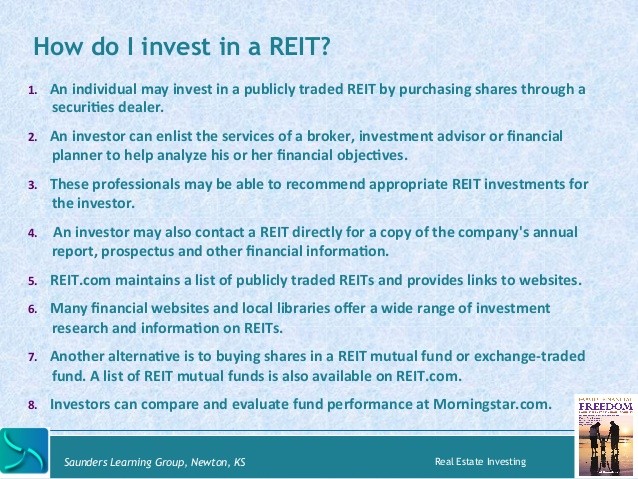Book Offers Road Map to REIT Investing
Post on: 16 Июнь, 2015 No Comment

05/10/2013 | By Carisa Chappell
Stephanie Krewson, vice president of investor relations at Corporate Office Properties Trust (NYSE: OFC), says she wrote her book,REIT Roadmap ,” in 2010 before joining COPT, to serve as a succinct resource on investing in REITs.
Prior to COPT, Krewson was an analyst covering REITs for Salomon Smith Barney and JP Morgan Chase. She wrote the book while on sabbatical from Wall Street. The first edition rolled off the presses in June 2011 and the second edition became available in September 2012.
The book addresses issues ranging from descriptions of major REIT property types to taxation of dividends to performance metrics. She specifically planned for the book, which is currently being used as required reading in courses at Georgetown University and the James A. Graaskamp Center for Real Estate at the Wisconsin School of Business, to be less than 100 pages long.
In an interview with REIT.com, Krewson discussed her inspiration for the book as well as advice for investors who are new to the REIT market.
REIT.com: What inspired you to write “REIT Roadmap?”
Stephanie Krewson: I realized there was a gap in the educational tools available to investors. Although REITs today are an established asset class, there are still so many investors who don’t know about REITs, or, if they know of them, they don’t know enough to invest in them or even have an informed conversation with their financial advisors. I wanted to create a thorough but brief and easy-to-understand resource that would help bring new investors into the REIT industry by making REITs intellectually accessible.
Many helpful books about REITs already existed, but each had the same three issues. First, they assumed the reader already had some basic level of REIT knowledge. Second, each of the existing REIT books was at least 250 pages in length. Most people just don’t have that much time to read about REITs. Third, no one book contained all the information an investor would need to learn about and then analyze individual companies.
So, the challenge was to write a handbook about REITs that discussed every essential topic, including valuation metrics like NAV, used plain English that even a novice investor could understand, and to do all of this in 100 pages or less. After about 60 re-drafts, “REIT Roadmap” finally met each of these criteria.
REIT.com: How would you say that investors’ perceptions of REITs have changed over the years?
Krewson: Investor perception of REITs could not be more different today than in 1994 when I began my career in REITs. Back then, REITs were still viewed as an alternative investment, rather than an accepted asset class. The industry’s market cap was less than $50 billion dollars, which was spread over more than 200 companies, so REITs generally were small-cap companies that attracted retail investors. Back then, you still had to explain to investors that REITs were not limited partnerships and that the investor would not need to wait for their Form K-1 to arrive in the mail in order to do their taxes.
Since 2001 when the S&P committee admitted the first equity REIT into their 500 index, the REIT industry has grown and changed exponentially, as has investors’ perception. Today, there are over 170 publicly traded REITs, and the industry’s market cap exceeds $625 billion. Although the market place for REIT shares is still not as liquid it is for other investments, liquidity generally is not an impediment to investing, especially in the large- and mid-cap REITs. REITs may still be viewed as alternative investments by some portfolio managers, but they are a well-established and valid asset class.
REIT.com: In your experience, what are the most important things that investors who are new to REITs should know?
Krewson: I would advise them that predicting total returns for REITs is more complicated than for other industries. Other companies, like Apple or Home Depot, trade off of future sales expectations. REIT share prices reflect both future leasing expectations and cash flows from leases that were signed in the past, unless you’re dealing with hotel REITs. which have no leases. Because of this past-future revenue mix, current REIT performance rarely reflects the current real estate fundamentals.
But this is probably is too subtle a concept for someone new to REITs. Instead, I’d probably give three pieces of advice that are easy to measure and follow:

Debt is risk. No company ever went bankrupt because it had too little debt.
Dividends are only attractive if they are safe. Look at forward dividendseparator_slashFFO payouts (or AFFO payouts, if you have access to that data) and invest in REITs that have lower, more conservative payout ratios.
Match your risk tolerance to REITs that invest in appropriate property types. If you have a low risk tolerance, you probably shouldn’t invest in hotel REITs. which trade with the greatest volatility of any property sector. Conversely, if you have a high risk tolerance, triple-net REITs will not likely fill your need for adrenaline.
REIT.com: How was the transition going from an analyst to vice president of investor relations?
Krewson. I love it. I knew I wanted to work at a REIT, rather than go back to Wall Street. Investor relations is a very different role at each company, depending on where that company is in its evolution. I knew I still wanted to be involved in financial modeling, as well as writing and marketing, so it was a matter of finding a company whose needs aligned with my skills. COPT is a company I had always admired, not just for assets like The National Business Park, but for the culture of caring and respect that was always evident in my meetings with management over the years. It sounds touchy-feely, but it’s true.
REIT.com: Did having the perspective from both types of positions help?
Krewson: Absolutely. Knowing what the sell-side analysts and buy-side investors need to model our company has helped me work with other departments at COPT consistently assures our best practices for disclosure.
Also, you need to excel at multi-tasking when you work in IR. I think I earned a Ph.D. in that on Wall Street over the years.
Last, I would mention that the perspective on the REIT industry and the knowledge I gathered on individual companies’ experiences—which ones handled problems the best, which companies communicate most effectively, et cetera—have enabled me to share my knowledge as part of management’s decision process.














